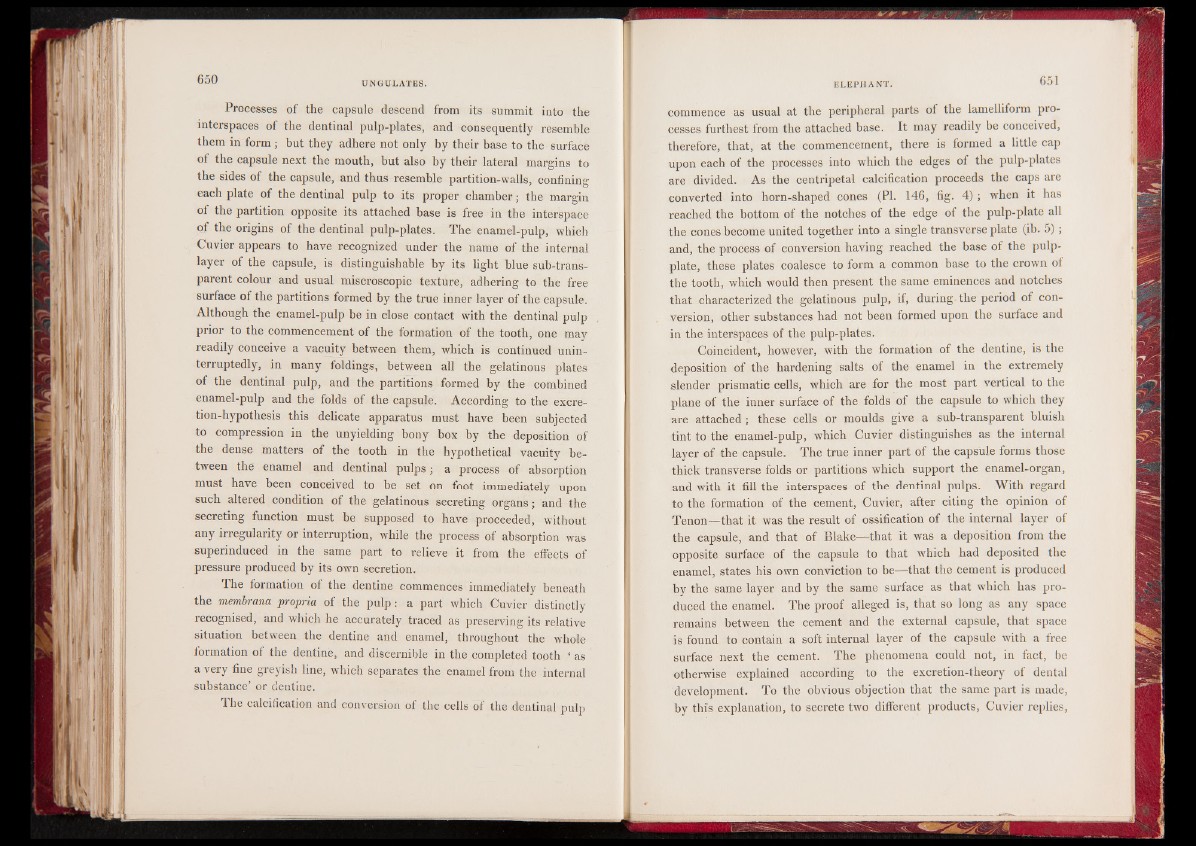
Processes of the capsule descend from its summit into the
interspaces of the dentinal pulp-plates, and consequently resemble
them in form ; but they adhere not only by their base to the surface
of the capsule next the mouth, but also by their lateral margins to
the sides of the capsule, and thus resemble partition-walls, confining
each plate of the dentinal pulp to its proper chamber; the margin
of the partition opposite its attached base is free in the interspace
of the origins of the dentinal pulp-plates. The enamel-pulp, which
Cuvier appears to have recognized under the name of the internal
layer of the capsule, is distinguishable by its light blue sub-trans-
parent colour and usual miscroscopic texture, adhering to the free
surface of the partitions formed by the true inner layer of the capsule.
Although the enamel-pulp be in close contact with the dentinal pulp
prior to the commencement of the formation of the tooth, one may
readily conceive a vacuity between them, which is continued uninterruptedly,
in many foldings, between all the gelatinous plates
of the dentinal pulp, and the partitions formed by the combined
enamel-pulp and the folds of the capsule. According to the excretion
hypothesis this delicate apparatus must have been subjected
to compression in the unyielding bony box by the deposition of
the dense matters of the tooth in the hypothetical vacuity between
the enamel and dentinal pulps; a process of absorption
must have been conceived to be set on foot immediately upon
such altered condition of the gelatinous secreting organs; and the
secreting function must be supposed to have proceeded, without
any irregularity or interruption, while the process of absorption was
superinduced in the same part to relieve it from the effects of
pressure produced by its own secretion.
The formation of the dentine commences immediately beneath
the membrana propria of the pulp: a part which Cuvier distinctly
recognised, and which he accurately traced as preserving its relative
situation between the dentine and enamel, throughout the whole
formation of the dentine, and discernible in the completed tooth ‘ as
a very fine greyish line, which separates the enamel from the internal
substance’ or dentine.
The calcification and conversion of the cells of the dentinal pulp
commence as usual at the peripheral parts of the lamelliform processes
furthest from the attached base. It may readily be conceived,
therefore, that, at the commencement, there is formed a little cap
upon each of the processes into which the edges of the pulp-plates
are divided. As the centripetal calcification proceeds the caps are
converted into horn-shaped cones (PI. 146, fig. 4) ; when it has
reached the bottom of the notches of the edge of the pulp-plate all
the cones become united together into a single transverse plate (ib. 5);
and, the process of conversion having reached the base of the pulp-
plate, these plates coalesce to form a common base to the crown of
the tooth, which would then present the same eminences and notches
that characterized the gelatinous pulp, if, during the period of conversion,
other substances had not been formed upon the surface and
in the interspaces of the pulp-plates.
Coincident, however, with the formation of the dentine, is the
deposition of the hardening salts of the enamel in the extremely
slender prismatic cells, which are for the most part vertical to the
plane of the inner surface of the folds of the capsule to which they
are attached ; these cells or moulds give a sub-transparent bluish
tint to the enamel-pulp, which Cuvier distinguishes as the internal
layer of the capsule. The true inner part of the capsule forms those
thick transverse folds or partitions which support the enamel-organ,
and with it fill the interspaces of the dentinal pulps. With regard
to the formation of the cement, Cuvier, after citing the opinion of
Tenon—that it was the result of ossification of the internal layer of
the capsule, and that of Blake—that it was a deposition from the
opposite surface of the capsule to that which had deposited the
enamel, states his own conviction to be—that the cement is produced
by the same layer and by the same surface as that which has produced
the enamel. The proof alleged is, that so long as any space
remains between the cement and the external capsule, that space
is found to contain a soft internal layer of the capsule with a free
surface next the cement. The phenomena could not, in fact, be
otherwise explained according to the excretion-theory of dental
development. To the obvious objection that the same part is made,
by this explanation, to secrete two different products, Cuvier replies,